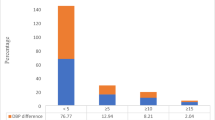Abstract
The aim of this study was to investigate that inter-arm blood pressure (BP) difference (IAD) and reference arm in 420 post-stroke patients with hemiparesis. Synchronous bilateral-arm BP was measured with two automatic BP devices, and the systolic BP difference of ≥10 mm Hg was recorded as increased sIAD. The arm with higher systolic BP (SBP) was assigned as the reference arm. Our results showed that the prevalence of sIAD was 18.1% in the total group. The paretic arms had similar mean SBP levels (133.6±18.4 vs. 133.8±18.4 mm Hg, NS) and DBP (77.8±11.5 vs. 77.2±10.9 mm Hg, NS) as compared with the unaffected arms. The detection rate of hypertension or uncontrolled hypertension on the SBP values of the reference arm was higher than that on the unaffected arm (41.8% vs. 36.3%). It is concluded that in the post-stroke patients with hemiparesis in the rehabilitation period, the prevalence of sIAD ≥10 mmHg was relatively higher, and using the unaffected arm, rather than the unaffected arm, for BP measurement could induce correctly detection of hypertension.
This is a preview of subscription content, access via your institution
Access options
Subscribe to this journal
Receive 12 digital issues and online access to articles
$119.00 per year
only $9.92 per issue
Buy this article
- Purchase on Springer Link
- Instant access to full article PDF
Prices may be subject to local taxes which are calculated during checkout
Similar content being viewed by others
Data availability
not applicable.
References
Pickering TG, Hall JE, Appel LJ, Falkner BE, Graves J, Hill MN, et al. Recommendations for blood pressure measurement in humans and experimental animals: part 1: blood pressure measurement in humans: a statement for professionals from the Subcommittee of Professional and Public Education of the American Heart Association Council on High Blood Pressure Research. Circulation 2005;111:697–716.
Williams B, Mancia G, Spiering W, Rosei EA, Azizi M, Burnier M, et al. 2018 ESC/ESH Guidelines for the management of arterial hypertension: The Task Force for the management of arterial hypertension of the European Society of Cardiology (ESC) and the European Society of Hypertension (ESH). Eur Heart J. 2018;39:3021–104.
Whelton PK, Carey RM, Aronow WS, Casey DE, Collins KJ, Himmelfarb CD, et al. ACC/AHA/AAPA /ABC/ACPM/AGS/APhA /ASH/ASPC /NMA/PCNA. Guideline for the Prevention, Detection, Evaluation, and Management of High Blood Pressure in Adults. Hypertension 2018;71:13–5.
Clark CE, Taylor RS, Shore AC, Ukoumunne OC, Campbell JL. Association of a difference in systolic blood pressure between arms with vascular disease and mortality: a systematic review and meta-analysis. Lancet. 2012;379:905–14.
Singh S, Sethi A, Singh M, Khosla K, Grewal N. Simultaneously measured inter-arm and inter-leg systolic blood pressure differences and cardiovascular risk stratification: a systemic review and meta-analysis. J Am Soc Hypertens. 2015;9:640–50.
Singh S, Sethi A, Singh M, Khosla S. Prevalence of simultaneously measured interarm systolic blood pressure difference and its clinical and demographic predictors: a systemic review and meta-analysis. Blood Press Monit. 2015;20:178–85.
Das S, Iktidar MA, Das J, Chowdhury F, Roy S. Inter-arm blood pressure difference as a tool for predicting coronary artery disease severity. Open Heart. 2022;9:e002063. 10210 https://doi.org/10.1136/openhrt-2022-002063.
Dewar R, Sykes D, Mulkerrin E, Nicklason F, Thomas D, Seymour R. The effect of hemiplegia on blood pressure measurement in the elderly. Postgrad Med J. 1992;68:888–91.
Shenberger JS, Leaman GJ, Neumyer MM, Musch TI, Sinoway LI. Physiologic and structural indices of vascular function in paraplegics. Med Sci Sports Exerc. 1990;22:96–101.
Wang JS, Yang CF, Liaw MY, Wong MK. Suppressed cutaneous endothelial vascular control and hemodynamic changes in paretic extremities with edema in the extremities of patients with hemiplegia. Arch Phys Med Rehabil. 2002;83:1017–23.
Harvey RL. Hemiplegia and contralateral upper limb claudication-a case of dual disability from pseudoaneurysm of the brachiocephalic artery: a brief report. Am J Phys Med Rehabil. 1999;78:56–9.
Yin MZ, Kim HJ, Suh EY, Zhang YH, Yoo HY, Kim SJ. Endurance exercise training restores atrophy-induced decreases of myogenic response and ionic currents in rat skeletal muscle artery. J Appl Physiol. 2019;126:1713–24.
Garland M. Practical Management of Stroke. Postgrad Med J. 1985;61:1026.
Yagi S, Ichikawa S, Sakamaki T, Takayama Y. Murata K Blood pressure in the paretic arms of patients with stroke. N. Engl J Med. 1986;315:836.
Yin L. Foundation of Nursing Science [M]. Beijing: People ’s Medical Publishing House, 2004: 98.
Brunnstrom S. Motor testing procedures in hemiplegia: Based on sequential recovery stages. Phys Ther 1966;46:357–75.
Clark CE, Taylor RS, Shore AC, Campbell JL. Prevalence of systolic inter-arm differences in blood pressure for different primary care populations: systematic review and meta-analysis. Br J Gen Pr. 2016;66:e838–47.
Yu Y, Liu L, Lo K, Tang S, Feng Y. Prevalence and associated factors of inter-arm blood pressure difference in Chinese community hypertensive population. Postgrad Med. 2021;133:188–94.
Tao L, Tang M, Peng HP, Gu MB, Zhang HZ, Zhou G, et al. Is the blood pressure different between the paralyzed and unaffected arms or legs? Blood Press Monit. 2020;25:242–5.
Clark CE, Warren FC, Boddy K, McDonagh STJ, Moore SF, Alzamora TM, et al. Higher arm versus lower arm systolic blood pressure and cardiovascular outcomes: a meta-analysis of individual participant data from the INTERPRESS-IPD Collaboration. Hypertension 2022;79:2328–35.
Author information
Authors and Affiliations
Contributions
Data collection and analysis: HP, LT, MT, Write and design: HS.
Corresponding author
Ethics declarations
Competing interests
The authors declare no competing interests.
Additional information
Publisher’s note Springer Nature remains neutral with regard to jurisdictional claims in published maps and institutional affiliations.
Rights and permissions
Springer Nature or its licensor (e.g. a society or other partner) holds exclusive rights to this article under a publishing agreement with the author(s) or other rightsholder(s); author self-archiving of the accepted manuscript version of this article is solely governed by the terms of such publishing agreement and applicable law.
About this article
Cite this article
PENG, Hp., TAO, L., TANG, M. et al. Inter-arm blood pressure difference in post-stroke patients with hemiparesis. J Hum Hypertens 38, 228–231 (2024). https://doi.org/10.1038/s41371-023-00886-y
Received:
Revised:
Accepted:
Published:
Issue Date:
DOI: https://doi.org/10.1038/s41371-023-00886-y



